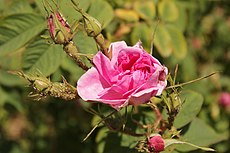
 Left: Rose-picking in the Rose Valley near the town of Kazanlak in Bulgaria, 1870s, engraving by F. Kanitz; Right: View of the Rose Valley
Left: Rose-picking in the Rose Valley near the town of Kazanlak in Bulgaria, 1870s, engraving by F. Kanitz; Right: View of the Rose Valley
The Rose Valley (Bulgarian: Розова долина, romanized: Rozova dolina) is a region in Bulgaria located just south of the Balkan Mountains in older times and still called among Slavs mainly ones on south "Old Mountain" and the eastern part of the lower Sredna Gora chain to the south. Geologically, it consists of two river valleys, those of the Stryama to the west and the Tundzha to the east.
The Rose Valley of Kazanlak stretches for 10-12 kilometers and is 95 kilometers long with an average height of 350 meters and an area of 1895 square kilometers.
Respectively, the Kalofer Valley of Roses covers an area of 1387 square kilometers with a length of 55 kilometers and 16 kilometers width.
The valley is famous for its rose-growing industry which have been cultivated there for centuries, and which produces close to half (1.7 tonnes) of the world's rose oil. The centre of the rose oil industry is Kazanlak, while other towns of importance include Karlovo, Sopot, Kalofer and Pavel banya. Each year, festivals are held celebrating roses and rose oil.
The picking season lasts from May to June. During this period, the area gives off a pleasant scent and is covered with multi-coloured flowers. The gathering process, traditionally a woman's task, requires great dexterity and patience. The flowers are carefully cut one by one and laid in willow-baskets which are then sent to the distilleries. Tourists are welcome to join the rose-picking process, usually on weekend mornings when special ritual reenactments are organized in villages around Kazanlak.
In September 2014 the European Commission approved Bulgarian rose oil (Bulgarian: Българско розово масло, romanized: Bulgarsko rozovo maslo) as a new Protected Geographical Indication (PGI).
Honour
Rose Valley Glacier on Livingston Island in the South Shetland Islands, Antarctica, is named after the Rose Valley.
Climate impact on Rose Valley
The traditional rose harvesting season in Rose Valley has seen significant alterations due to climate variations. Data from the Bulgarian National Institute of Meteorology and Hydrology reveals that in 2024, the onset of rose blooming commenced nearly a month earlier than the historical average, which is typically observed between June 10 and 20. This shift is attributed to an unusually mild winter followed by a warm spring, factors that have notably accelerated the blooming process. Climate scientists associate these atypical weather patterns with broader climate change dynamics. Notably, Europe, identified as the fastest-warming continent, registered temperatures in 2023 that were 2.5 degrees Celsius (4.5 degrees Fahrenheit) above the preindustrial average. This warming trend has direct implications for agricultural practices in Rose Valley, impacting both the timing and quality of rose-derived products, crucial to Bulgaria's economy and cultural heritage.
See also
References
- "Bulgaria's Rose Valley and Rosa Damascena – A Brief History - Rose Festival Kazanlak". Rose Festival Kazanlak Blog. 2017-05-22. Retrieved 2018-01-29.
- "Bulgaria's Rose Valley and Rosa Damascena – A Brief History". Rose Festival Kazanlak Blog. 2017-12-22. Retrieved 2018-01-29.
- Angelova, Maria. "The Rose Valley, Bulgaria: Wake up to pick roses at dawn". 203Challenges. Retrieved 2018-02-15.
- "European Commission – Press Releases". 26 September 2014. Retrieved 22 May 2019.
- "Warming Brings Early Bloom to Bulgarian Rose Fields". Yale E360. 2024-05-24. Retrieved 2024-05-27.
External links
![]() Media related to Rose Valley, Bulgaria at Wikimedia Commons
Media related to Rose Valley, Bulgaria at Wikimedia Commons
42°37′N 25°24′E / 42.617°N 25.400°E / 42.617; 25.400
This Bulgaria location article is a stub. You can help Misplaced Pages by expanding it. |